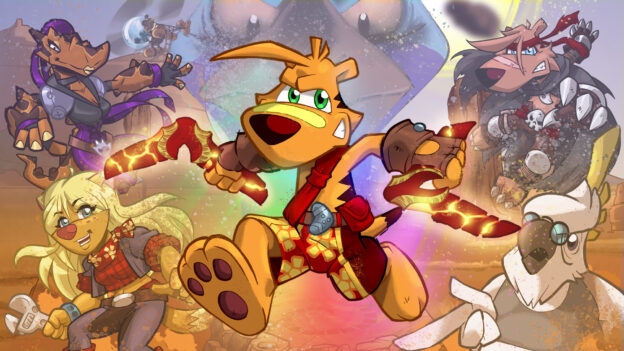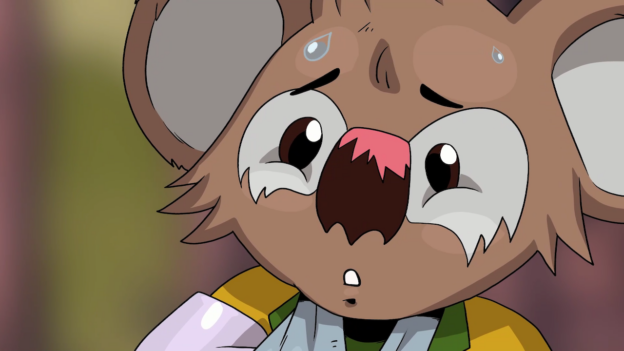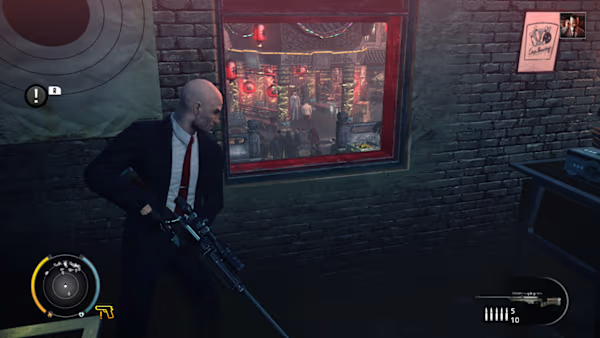Pure Nintendo interviews Krome Studios, developer of Ty the Tasmanian Tiger!

Ty the Tasmanian Tiger 4 is about to be released on the Nintendo Switch. After 20+ years, the series has seen many changes. Pure Nintendo was lucky enough to sit down with Steve and George from Australian-based company Krome Studios to talk about Ty the Tasmanian Tiger, the history of the series, and the new voiceover work.

PN: Thanks so much for your time today! I’d love to know more about Krome and its history; what’s your background and how did you come together to begin developing games?
Steve: Well, the legends tell of these guys who were working on this bodyboarding game from two different companies and they thought, hey this has worked out really good. We should join together, and this was like 1999, and that was us forming Krome. It was like, well let’s work together, because we’ve got a business guy and we’ve got these art guys who make games, let’s get together and that was how Krome was born. It was just that simple, like good to go?
PN: Awesome. Does the name mean something, Krome?
Ah no, I had an idea for a character called Krome like a robotic platforming game character. I’d just like the spelling was K-R-O-M-E, so we wanted it because this is like the 2000s, Internet names and trying to find something that’s a word. It’s like, shiny chrome but it’s not “chrome”. No one had any better ideas. So we stuck with the worst.
PN: And so you two have been doing work together since the late ‘90s?
Steve: Um, we’ve been brothers since 1973!
PN: Oh, you guys are brothers? Awesome! Okay, yeah.
Steve: Now George did some work on one of the first games we did, and he was off doing other stuff and then we formed Krome. We were looking for an audio guy and basically, I said I’ve got a brother who does it! it wasn’t like nepotism stuff, it’s just like, yeah, he does audio, let’s give him a go.
PN: Cool. That’s awesome, and 20+ years later obviously it’s working. Feel free to add something to that, George, if you like.
George: No, that’s pretty much it. It’s far less waffly than I would have come up with!
PN: Do you let the music do the talking for you usually?
George: No, and, you know, games have all these different elements. There’s the art. There’s the design. There’s the programming and there’s the audio. So, I tend to confine myself just to the audio part of it because that’s my thing. For all the other stuff, leave it to people like Steve.
Steve: I get to do all the work!
PN: The character of Ty the Tasmanian Tiger has been kicking around since 2000, with the first game released in 2002. Can you tell me a little about how the concept came about?
Steve: Yes, but we did need time to make it. But what happened was, at the end of 2000, Robert came back from overseas and had a friend who was at Sony, like a producer who’s doing all these platform games. We had wanted to do one for ages, like a character platformer, because we were big fans of Banjo Kazooie and Mario at the time. The stuff they think of as Playstation 2 titles, none of that existed.
There was Ridge Racer and a couple of games like on the PlayStation 2, and it’s like: that’s the cool new stuff. So we were sitting around what we call the blue room, it was basically a couple of blue couches in the office area, and as a group we were going, well, yeah; we should do that. And then it was like, it should be an Australian critter because Crash Bandicoot is so un-Australian. If you didn’t know what a bandicoot was, you wouldn’t know that it was an Australian animal. We should do a Tasmanian Tiger!
It was unanimous. There was no question about it. One of the other artists came up with the idea of using boomerangs as the weapon, we were like, that’s genius! It was just one of these things, everyone was throwing ideas in and it was this big melting part of cool Australian-isms.
They all fit together because we have a lot of the same history, roughly we’re the same ages and so we had all that cultural history. And another thing with Ty was that the games we did before that were much more international. We don’t have to be Australian, there’s that cultural cringe thing, you know, and with Ty it was like, we’re going to be Australian! We’re going to really lean into the stuff that makes us Australian, and the funny thing is the American guys at EA were like: “No, more Australian!” So our mission in life is to convert American kids to speaking Australian and knowing Australian stuff.
I don’t think we realize what we’ve got as far as all that stuff is. I was walking this morning and there’s a sulphur-crested cockatoo flying around, and a ton of ibis, and four or five gallas sitting in the park next door feeding. We just need to sit and watch a bit more I think.
PN: Has Ty the Tasmanian tiger changed over the years?
Steve: Yeah, he has. There’s been some really major changes in Ty. He changes his shorts every game. So that’s the big change! We try to keep his personality the same, he’s a really happy guy. He’s kind of a surfer guy but not a surfer dude if you know I mean. He runs around barefoot on the beach but he does help his mates out, we always try to keep that. So whatever the story, it’s that guy reacting to whatever the situation is, which I think makes him interesting.
He’s getting a little smarter over the years. He was never dumb, but now he’s sort of, I don’t trust you as much, like with Lenny the lyrebird and those characters. He just knows they’re doing bad stuff. So he’s picking up on that.
He did learn to drive in one of the games, which is big because Shaz always drove him around previously. But yeah, the joke is that I just changed his shorts mostly to give them something new to look at. There are design things we do, things with the models and in-game, adding mechanics and the way we render the characters, so that would always progress every game. Cloth technology as well, so we gave him a scarf running around in one of the games and he’s always got different abilities, like the different boomerangs. Game stuff always changes and we try to advance that as well, but the character is this nice guy helping his friends out and trying to do the right thing.
PN: Living in Australia, we know how diverse our country is. It makes a great setting for a video game. Can you tell us a bit about the inspiration for the settings and characters?
Steve: Well when I was a kid about 12, I did a week’s stay up at Mount Isa on a farm. We’re up there and the first day we got in the back of the Toyota Land Cruiser and we were driving around checking all the fences for the cattle. We were dodging termite mountains, like just driving there in the back of the ute. That was inspiration for some of the Ty level stuff. It literally was like we’re in the outback driving around and dodging termite mounds. And everyone added to that, like the rest of the team came up with ideas, like particularly the rainbow eucalyptus trees. So we just started saying “oh I love this thing, the beaches, and what kind of animals we have.” The stuff that we have fond memories of, and I think that’s just come from the whole team.
PN: Players from overseas may not know that the Tasmanian Tiger is actually extinct. How did you choose the Tasmanian tiger as your protagonist? Is that something that’s personal to you/your team?
Steve: I just always thought they were a cool, interesting animal, even just the name “Tasmanian Tiger”. I think in the late ‘90s Cascade Brewery started doing their stuff so they were getting noticed more as well. It was sort of around a bit more in your head and also, like I said, the Crash Bandicoot stuff. So what’s an Australian thing that’s interesting that hasn’t been done to death? We can’t do a kangaroo or a koala, you want to avoid that sort of stuff. Well, what’s left? You have this extinct Tasmanian Tiger that’s kind of cool and then you’d look up more info and it’s like, oh wow, they were really interesting. They can jump. They’ve got a pouch. The jaw that unhinges and opens up, that’s all perfect stuff for a game, and of course historically they were known for wearing shorts.
PN: Ty the Tasmanian Tiger 4 is a side-scroller as opposed to a 3D platformer. This was a change for the mainline series, what brought about this new direction? How different is development comparing 3D and 2D titles?
Steve: Well technically it is the third 2D game. Here’s how it works in my head: There’s a Venn diagram of the games. There are three 3D games and there are three 2D games, with a crossover with two of the 2D games. They’re the same story. So the numbering for me is the story. Not the actual style of game.
Gameplay-wise what happened was we were talking to Microsoft who were looking to release games for Windows 8 on the tablet and then we’re talking about doing a side-scrolling game. They really wanted to have something side-scrolling. They didn’t have any particular IP they wanted. They just wanted a side-scrolling game that would run nicely on a tablet. This was 2013 and we hadn’t done a Ty game since 2005. We’ve tried to do lots of Ty games. That’s the way the business was going and timing. So I’ve never kind of got it off its feet.
I had also been working on my own before that to work out how to do a 2D platform again with the sprites and stuff we use for Ty. So I’d started playing around with that idea that we could probably do this. Luckily, the guy at Microsoft we were talking to actually had worked on Ty and was a Ty fan so it just made it all easy.
The idea was that we would reintroduce a lot of stuff the players who’d played the series knew about and also introduce new players. So it’s kind of like, hey welcome back to Ty, all the gameplay stuff is in there from the games like gliding, jumping, biting, swimming, riding animals, diving games, chases all that stuff’s in there. It’s literally if you took a normal Ty game and squashed it, that’s what you get as a 2D game, which was what we had on the Game Boy games. But it’s a bit more advanced because you have full HD graphics and the cool level stuff we were doing, which we would see in Ray Man, hey they have stuff that’s not block shaped! We should try this! so we were looking at what else was being done. We were just trying to advance a 2D game.
PN: The animation is really smooth in the Switch version – I’m lucky to have had a go at the game already! Can you tell me about the improvements between this version and the original Ty the Tasmanian Tiger 4?
Steve: There’s mostly just keeping it at a good frame rate because pc it’s a bit ifffy like what you miss hardware was going to be. There was a whole bunch of different hardware that even the Windows 8 version had to support the Steam version. Obviously we could have that running faster. But it’s a bit harder to know still what speeds are going to run at.
With the switch you have the locked-off frame rate. You know the hardware. It’s going to be 720p on docked. It’s going to be 1080p handheld. It’s much easier to make it work nicer and focus on it.
One of the biggest comments previously was oh there’s no voiceover stuff. It was just silent text box stuff that was cheap. The cut scenes were just static frames originally. So, what we decided to do was get all the voice actors together. We had to cast some new voices, we got a whole bunch of the old ones and we recorded all the audio and it’s just jumps from “it’s a good game” to “oh wow”! And that’s us saying, yeah oh this is great.
And then the cut scenes we basically reanimated them. They were just going to be simple sliding motion graphics. It’s like, oh we got the voices, now I should probably just lip sync in it a little bit. It’s not really a full-on type of animation but it is nice. It’s simple. You get action going on. It’s not just static screens and it just feels a lot more visual and exciting to watch when stuff’s moving across the screen as the voice goes and the music’s playing. So yeah, that was a big.
PN: Do you do any voices in the game?
Steve: I do one voice. You have to guess who it is; he may or may not be called Steve…
PN: You’ve worked across many Nintendo platforms over the years including the GameCube, Game Boy Advance, and Nintendo Switch. How has that process changed over time – is it easier in 2023? Which is your favorite system to work with?
Steve: The Switch is the one that I like playing stuff on. I love the Switch as a unit. It doesn’t have all the power of the others but I like that it’s portable … even though I don’t go anywhere. It feels like this is the stuff I imagined we were designing for back in the ‘90s, so I want cool technology.
Game dev-wise, the GameCube dev kits were a bit of a pain, but so was everything else at that time.
George: [The Switch] is a lot easier to work with compared to even older Nintendo ones, which used to take up about sixty USBs on your computer and whenever they crashed they’d play one cycle of sound, which is not even a frame. So it would sound like your fuse box was about to explode until you muted your speakers or whatever.
It’s a little daunting at first, though, but once you’ve got it [the Switch] works really, really well and it’s fast. There’s no comparison. Waiting for something to render now as opposed to on the GameCube, that would take forever to get anything where you could actually test something. So the test hardware now is phenomenal compared to what it used to be.
Steve: And nothing compares .. I’m gonna say this, when we did the Ty console versions, the coolest thing for me is the Switch red logo with the click at the start of a trailer. You don’t know how much that means, like I’ve been making games for 30 years, we would go to Nintendo at E3 and say, can we have a meeting? So we were always trying to get on Nintendo and it was nice having games on there.
PN: Amazing! For budding developers or people entering the scene, do you have any advice?
Steve: There is a lot more technology out there and tools to make games. It’s a lot easier to use. Just go make games. It doesn’t have to be photo-real rendered, that’s nice but you can make any little game you want. It could be a 2D pixel thing. There’s asset stores now you can get if you can’t get graphics. Get your music and graphics from an asset store or tools you can make a game with.
One of the things when we were hiring people but we started Krome was if people had made a game. It doesn’t matter how crappy it was. It goes a long way to getting you a job if you’re going to be a developer. The other thing is that now you don’t have to wait for someone to give you the money for it, you can make it and release it and get games out that way. So make stuff. That’s the first thing, just make stuff.
PN: Cool, just do it, take that step, that’s awesome. Thank you so much for your time today to talk about Ty the Tasmanian Tiger! It’s been an interesting journey through the series’ history and we reallyt appreciate your time.
Ty the Tasmanian Tiger 4 hits the Nintendo on September 26. Also check out our latest podcast episode for another part of this special interview. Watch for our upcoming review of Ty the Tasmanian Tiger 4.






